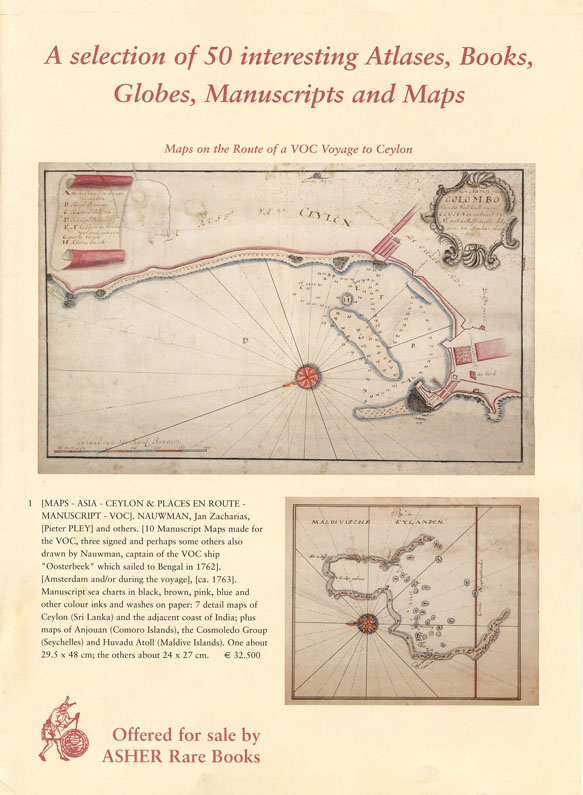Maps, Books, and Manuscripts From Asher Rare Books

Maps, Books, and Manuscripts From Asher Rare Books
By Michael Stillman
Asher Rare Books has just released a new catalogue entitled "A selection of 50 interesting Atlases, Books, Globes, Manuscripts and Maps." Asher Rare Books is located in the Netherlands, so this catalogue skews a bit toward Dutch items, but there are several other European nations represented, along with one piece that is very American. Here are a few examples of items to be found in this fully illustrated catalogue of rare and intriguing works.
The first item offered is a collection of ten manuscript maps taken from a journey to Ceylon (now Sri Lanka) circa 1763. They were generated either during the voyage of the ship "Oosterbeck" or upon its return to Amsterdam. Along with sea charts are seven maps of Ceylon and the adjacent Indian coast, and one each of the Comoro Islands, Seychelles, and Maldive Islands (using current names). Sadly, this area of the world has been very much in the news recently with the earthquake and devastating tsunami. A few of these maps can be seen in the picture of the catalogue's cover on this page. Item 1. Priced at (Euros) €32,500 (or equivalent US $43,517).
For those with an interest in book catalogues, here is a pair of very old ones. They were offered by Janssonius Van Waesberge in 1725 and 1727. One is a catalogue of books in Italian, Spanish, and English, the other of French books on history, geography, genealogy, mathematics, literature and more. They are bound as one and contain listings for 5,750 books. Item 22. €3,850 (US $5,154).
Item 14 is an 1831 explanation for the Aurora Borealis or Northern Lights that light up the nighttime skies of places that are very cold at this time of year. The book is Der Polarschein, oder: Das Nordlicht, by Siegmund Dietmar, published in Berlin in 1831. Dietmar theorized that the phenomenon was caused by the reflection and refraction of sunlight by ice crystals high above the North Pole. That was not a bad theory considering the lack of knowledge of solar particles and winds at the time, but it was completely wrong. Nice try. €2,950 (US $3,950).
Item 19 is the one of Americana. It is Ichthyology of South Carolina by John Edwards Holbrook, published in Charleston in 1860. This is the second and expanded edition, and is called "volume 1," though there were no more. The book includes 28 hand-colored plates of fish which lived in the waters of South Carolina. Holbrook was a physician and member of the faculty at the Medical College of South Carolina. The date of this publication is of more than passing significance. It was the year in which South Carolina seceded from the Union. Dr. Holbrook, well into his 60s, would be called to serve soldiers on the battlefield for the Confederacy, while further publication of his book would cease. The Civil War left few in America untouched. €12,500 (US $16,743).
Georges Cuvier was one of the world's foremost zoologists of the early 19th century. He prepared classifications for thousands of animals, both alive and extinct. He believed that each part of an animal's body was critical to its function. Therefore, he reasoned that change, or evolution, was not possible. However, he recognized that many fossilized animals no longer existed, so he concluded that there were periodic cataclysmic events which wiped out many animals, a theory that seems to have been confirmed by recent discoveries. The follow up part of his theory, that there were new creations rather than new evolutions, has not been supported. Item 10 is Regne Animal dispose en Tableaux Methodiques... by Cuvier and Joseph Achille. Published in 1840, it includes drawings of approximately 5,000 animals, including humans of different ethnicities. €3,750 (US $5,022).